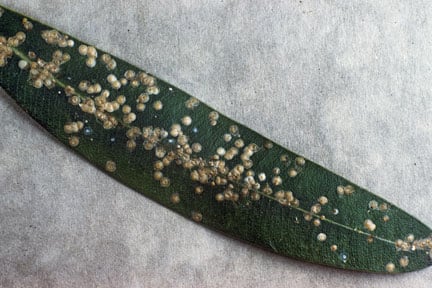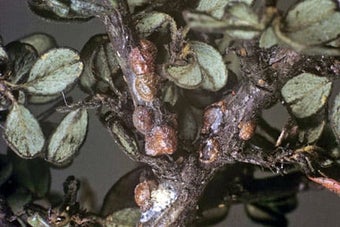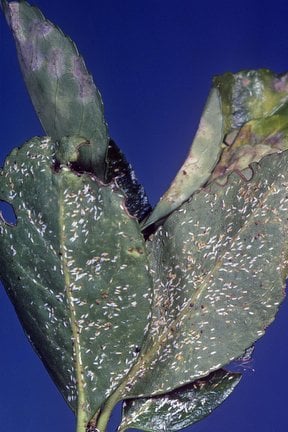
Quick facts
Common name - Oleander scale
Scientific name - Aspidiotus nerii
Plants affected - A variety of glasshouse plants
Main symptoms - Whitish 2 mm diameter scale insects on leaves and stems
Caused by - Sap sucking scale insects
Timing - All year
What is oleander scale?
Oleander scale is a sap sucking true bug that appears as a flat, oval, whitish-brown insects on leaves and stems of indoor plants. The whitish covering of the insect is waxy and repels liquids. The adults reach up to 2 mm long, the immature stages (crawlers) are much smaller. It does not produce honeydew and breeds throughout the year. It is one of several species of scale insects encountered by gardeners.
Scale insects are sap sucking true bugs belonging to several families in the Hemiptera. Typically the adults are immobile having a flattened or raised appearance, with no visible legs. They often look like a ‘scale’ on a leaf or stem, many species produce a white wax often covering egg masses. There are more than 100 species found in Britain, 26 of which have been introduced. More than 25 species can be found in gardens or on houseplants.
Symptoms
Populations of oleander scale are characterised by encrustations of the 2 mm diameter scales on leaves and stems of glasshouse plants. Common host plants include Acacia, Asparagus plumosus, azalea (Rhododendron), Cyclamen, Dracaena, Nerium oleander (oleander) and palms. Heavily affected plants can lack vigour. It can appear similar to other diaspid scale insects.
Management
- Where possible tolerate populations of scale insects. Well-tended healthy plants are able to tolerate light populations of these insects, they are of little consequence and do not require management
- Adult scales and egg masses can be removed when seen but this may not reduce large populations
- It can be worth considering replacing heavily affected plants, although this is seldom a necessary measure


















